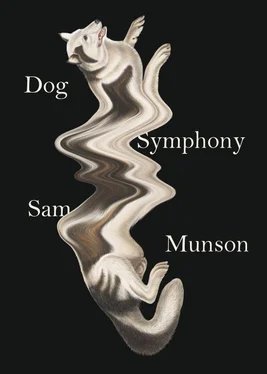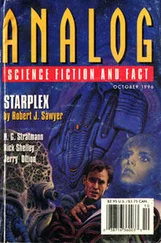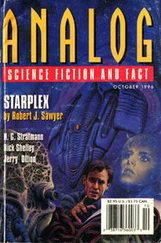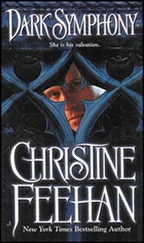I’m not fucking with you, sir. I honestly don’t know anyone by that name, or anything about the Department of Social Praxis, beyond what I said already. He was smiling, his tile-like teeth strong and dark yellow, his gums vivid. Then why did they give me this address, I asked, it can’t be a mistake — the street was just renamed. That’s true, said the spitter, his smile twisting and curling into horns, knives, a trident. Whatever you like. Yes, he said, that has confused people. As he spoke his pupils twitched, and I followed their arc. They had twitched toward a gate in the parking lot fence, closed with a loosely wrapped chain. I wish I could help you, sir, said the spitter, through his pollen-colored smile, I wish I could but I don’t know anything and only employees are authorized to be on the premises. Again his pupils jumped, again they indicated this gate in the fence, secured by its frivolous chain. A gate I could enter if I liked. And at the spitter’s invitation, so to speak, I was already heading toward this door, my molars already locked behind my own painful and obedient grin. The spitter’s smile had widened, as had the blank, titanically empty smile of the sky, the roofline, this deserted precinct. We had reached the gate, and I was waiting for the spitter to unwrap the chain when the door he had first exited opened again. A rat-faced boy in a sky-blue uniform with silver epaulettes leaned through and shouted: Olegario, get inside, what the fuck is the matter with you. The spitter looked at me. Real melancholy in his muddy eyes. He obeyed the uniformed boy. He glanced at me again before the door closed. One meager raindrop stroked my earlobe. Then another.
THAT GUY IS A real motherfucker, Adriano muttered, or so I hear. He was holding another match (whose flame I could hardly see in the glaring sunlight) to the black mouth of his pipe.
He meant Sanchis Mira. I told him everything about my bizarre evening on the roof while we were waiting in line at the Cárcel de Devoto. He listened with grave care, nodding, squinting, tapping more brick-brown tobacco into the bowl. He added that while he wished he’d been a professor he was glad he didn’t have to deal with them. He pointed at the squadron of University police standing guard around the entrance gates (next to the two steel bowls reflecting sunlight). Adriano turned out to know even more about the phenomenon of betting on dogs than Violeta did. The clubs of Hecate, he said, that’s nothing new. We had those under Videla and we had them under Rosas, too, it’s just part of our history. Not always dogs, though — at least that’s what it said in the article. And he wasn’t surprised, he added, about my friend. It happens all the time, he said, it started right after the epidemic too. Even before the night dogs showed up.
The line was composed mostly of old women wearing black kerchiefs striped with lilac. The liveried guards let them in five or six at a time, not bothering them or berating them. They asked for identification and then proffered their upturned caps. The first time I watched an old woman drop coins (they chittered telegraphically) into the cap, I found the gesture so nonsensical that it failed to make any impression, sordid or comical, at all. Adriano already held a fistful of change ready, taken from his wallet which, like the fobs his brother sold, also bore a GENUINE PAMPAS HARE label. I gathered up all the centavos (with their bloody smell) I had in my pockets. The cap the guard at the line’s head offered me displayed a sweat stain on the inner crown, shaped like a pretentious, second-rate nation.
The layout of the carcel did not correspond in any way to the plans of it I had seen. The prison had long been a basic instructional text for aspirants to my field. We all knew it by heart. Even my colleagues whose memories fell short of mine at least knew the carcel. When the structural changes had been made, Adriano didn’t know exactly. Some time after the epidemic, he said. The oblong garrison you passed through to enter was still there but in the center of the courtyard the fences I remembered from my studies had been demolished, creating a wide, broken-skinned expanse of concrete across which the old women moved with complete freedom, their striped kerchiefs fluttering. From the cracks in the asphalt grew rugged dandelions. The old ladies gathered up handfuls of these as they passed, crammed them into their purses or carried them tenderly in curled hands.
The tiered cellblocks — once the residences of luminaries, of the southern capital’s most phosphorescent luminaries — had been torn down. Their foundations remained, jagged, periodontal, enclosing patches of gravel, gray stones into which lines of blue stones had been set. On the last remaining walls, the outer walls, black oblong loudspeakers hung. It’s the church, said Adriano, you’ll see, they’re behind all of this. He muttered these words with downcast and mildly ashamed eyes. The center of the coffin-shaped grounds of the prison, on which all these old women seemed bent to converge (though I now saw a few other tourists, including four Germans in shorts, their knees crimson and their identical alpenstocks chopping the air), held a stumpy, open building made of cinder blocks and roofed with tin shingles. These looked molten in the sun. The old women here pressed thickly and strongly, they made forward movement difficult. You had to move at their numb, reverential pace or not move at all. We were gradually swept forward by this tidal motion, this erosive and mysterious motion, and I was able to see the building more clearly: it was a shrine, and within the gloom under its tin roof hundreds of squat candles burned and flickered. A name was lettered in orange paint on a wooden plaque hanging from the roof edge: SAN CRISTóBAL.
The saint wore a purple robe. He was toweringly tall. The crude-cut hands, painted white, gripped the robe under its white collar. And from the collar up… I could not believe what I saw. A dog’s head on the saint’s shoulders. St. Christopher has a dog’s head, Adriano whispered to me, I don’t know why but you can look it up, I remember from school. As he spoke, from the loudspeakers mounted on the inner courtyard wall came a breathy recording of bells. The Dog Symphony: that’s what it was, played on a carillon. The old ladies surged forward, one more human wave, and those in the first rank knelt and started to pray, they asked the saint to intercede for their dead sons and daughters, their dead sisters and husbands, on the perilous journey from death back into life, a journey like the journey our savior himself took. The prayer sounded rehearsed to me. Adriano said some priest had written it after the dogs first showed up. Or maybe not a priest at all, but some other authority — he couldn’t remember. We’d reached the shrine itself now, buoyed by the flood of old women. A damp cold emanated from the wooden walls and from the plaster statue itself. Steel troughs filled with white candles stood before the concrete hexagon beneath the shrine.
Adriano was kneeling, now, fumbling up a candle from the trough and lighting it with his own (secular) matches. He didn’t look at me, only at St. Christopher. The daylight once more rendered the flame almost invisible; but once he had placed it on the metal stands within the shrine it blazed a vivid orange, the color of the letters on the sign identifying the saint. I was now the sole person standing. Adriano muttered over his clasped hands, his eyes closed, rocking in the same cardiovascular rhythm as the old women. Around me the bent, hill-shaped backs, the gaudy and funereal kerchiefs, and the tolling song. Adriano interrupted his prayer to direct a guilty look at me, as though saying: What can I do? I don’t know where my instinct to kneel and join him came from, but burgher adventurism demands that you engage in such displays. Then again, it could have been my natural cowardice. I did not take a candle but I did murmur, over and over, a curt prayer for Ana’s safety as the soap-scented clothes of the old women rustled next to my ears. In the dim shrine, the candlelight spattered on a halo made of gold-painted plaster surrounding the canine head. You see, murmured Adriano, you see.
Читать дальше












